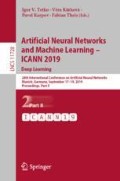Abstract
Feature ranking (FR) and feature selection (FS) are crucial steps in data preprocessing; they can be used to avoid the curse of dimensionality problem, reduce training time, and enhance the performance of a machine learning model. In this paper, we propose a new layer for deep neural networks - CancelOut, which can be utilized for FR and FS tasks, for supervised and unsupervised learning. Empirical results show that the proposed method can find feature subsets that are superior to traditional feature analysis techniques. Furthermore, the layer is easy to use and requires adding only a few additional lines of code to a deep learning training loop. We implemented the proposed method using the PyTorch framework and published it online (The code is available at: www.github.com/unnir/CancelOut).
Access this chapter
Tax calculation will be finalised at checkout
Purchases are for personal use only
Notes
- 1.
The bias term is omitted here, see Subsect. 3.1.
References
Chang, C.H., Rampasek, L., Goldenberg, A.: Dropout feature ranking for deep learning models. arXiv e-prints (2017)
Cybenko, G.: Approximation by superpositions of a sigmoidal function. Math. Control, Signals Syst. 2(4), 303–314 (1989). https://doi.org/10.1007/BF02551274
Dua, D., Graff, C.: UCI machine learning repository (2017). http://archive.ics.uci.edu/ml
Gilpin, L.H., Bau, D., Yuan, B.Z., Bajwa, A., Specter, M., Kagal, L.: Explaining explanations: an overview of interpretability of machine learning. arXiv e-prints (2018)
Goodfellow, I., Bengio, Y., Courville, A.: Deep Learning. MIT Press, Cambridge (2016). http://www.deeplearningbook.org
Kasneci, G., Gottron, T.: LICON: a linear weighting scheme for the contribution ofInput variables in deep artificial neural networks. In: Proceedings of the 25th ACM International on Conference on Information and Knowledge Management, CIKM 2016, pp. 45–54. ACM, New York, NY, USA (2016). https://doi.org/10.1145/2983323.2983746
Kingma, D.P., Ba, J.: Adam: a method for stochastic optimization. arXiv e-prints (2014)
LeCun, Y., Cortes, C.: MNIST handwritten digit database (2010). http://yann.lecun.com/exdb/mnist/
Li, Y., Chen, C.Y., Wasserman, W.W.: Deep feature selection: theory and application to identify enhancers and promoters. J. Comput. Biol. 23(5), 322–336 (2016). https://doi.org/10.1089/cmb.2015.0189. PMID: 26799292
Lundberg, S.M., Lee, S.I.: A unified approach to interpreting model predictions. In: Guyon, I., et al. (eds.) Advances in Neural Information Processing Systems, vol. 30, pp. 4765–4774. Curran Associates, Inc. (2017). http://papers.nips.cc/paper/7062-a-unified-approach-to-interpreting-model-predictions.pdf
Rumelhart, D.E., Hinton, G.E., Williams, R.J.: Learning internal representations by error propagation. In: Rumelhart, D.E., McClelland, J.L., (eds.) Parallel Distributed Processing: Explorations in the Microstructure of Cognition, vol. 1, pp. 318–362. MIT Press, Cambridge (1986). http://dl.acm.org/citation.cfm?id=104279.104293
Srivastava, N., Hinton, G., Krizhevsky, A., Sutskever, I., Salakhutdinov, R.: Dropout: a simple way to prevent neural networks from overfitting. J. Mach. Learn. Res. 15, 1929–1958 (2014). http://jmlr.org/papers/v15/srivastava14a.html
Zhang, Q., Nian Wu, Y., Zhu, S.C.: Interpretable convolutional neural networks. arXiv e-prints (2017)
Author information
Authors and Affiliations
Corresponding author
Editor information
Editors and Affiliations
Rights and permissions
Copyright information
© 2019 Springer Nature Switzerland AG
About this paper
Cite this paper
Borisov, V., Haug, J., Kasneci, G. (2019). CancelOut: A Layer for Feature Selection in Deep Neural Networks. In: Tetko, I., Kůrková, V., Karpov, P., Theis, F. (eds) Artificial Neural Networks and Machine Learning – ICANN 2019: Deep Learning. ICANN 2019. Lecture Notes in Computer Science(), vol 11728. Springer, Cham. https://doi.org/10.1007/978-3-030-30484-3_6
Download citation
DOI: https://doi.org/10.1007/978-3-030-30484-3_6
Published:
Publisher Name: Springer, Cham
Print ISBN: 978-3-030-30483-6
Online ISBN: 978-3-030-30484-3
eBook Packages: Computer ScienceComputer Science (R0)

